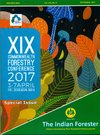Emissions Reduction Due to Avoidance of Forest Degradation: A Pilot Study
DOI:
https://doi.org/10.36808/if/2017/v143i9/118897Keywords:
REDD-Plus, Forest Degradation, Carbon Stock, Soil Adjusted Vegetation Index.Abstract
Deforestation and forest degradation contribute significantly to the warming of global climate systems. Forests on the other hand have the potential to remove the accumulated carbon dioxide from the atmosphere and sequester it into vegetation, soil and carbon continues to be locked for a long time in durable wood products. In view of the importance of the role of forests in mitigation of climate change, a 'Pilot study on REDD-plus' has been carried out on 9907 ha of Timli Forest Range of Kalsi Soil Conservation Division, Uttarakhand with the objectives to estimate the potential of emissions reduction due to avoidance of forest degradation. The Landsat satellite data of study area has been downloaded from USGS website and classified for the three time lines viz., 1998, 2008 and 2014 and for four different forest density classes viz., very dense forest, moderately dense forest, open forest and non forest by using ERDAS imagine software. Stratified random sampling technique has been applied for 2014 classified image and data was collected for three carbon pools, i.e., above ground biomass, below ground biomass and dead organic matter. Soil Adjusted Vegetation Index (SAVI) image has been generated for the three time lines for estimation of biomass of 1998 and 2008 and for biomass change detection. The study estimated that the total carbon stock for the year 2014 was 6,196,275.74 tonnes while for earlier years of 2008 and 1998 it was estimated to be 6,591,710.06 and 7,199,583.92 tonnes, respectively indicating significant amount of forest degradation.References
Anderson G.L. and Hanson J.D. (1992). Evaluating handheld radiometer derived vegetation indices for estimating above ground biomass. Geocarto International, 7: 71-78.
Anderson G.L., Hanson J.D. and Hass R.H. (1993). Evaluating landsat thematic mapper derived vegetation indices for estimating above ground biomass on semi-arid rangelands. Remote Sensing of Environment, 45:165-175.
Canadell J.G., Le Quere C., Raupach M.R., Field C.B., Buitenhuis E.T., Ciais P., Conway T.J., Gillett N.P., Houghton R.A. and Marland G. (2007).
"Contributions to accelerating atmospheric CO2 growth from economic activity, carbon intensity, and efficiency of natural sinks." Proceedings of the National Academy of Sciences, 104 (47): 18866-18870.
Champion H.G. and Seth S.K. (1968). A revised survey of the forest types of India, Government of India, New Delhi, ii + 404 pp.
FSI(1996).Volume equations for forests of India, Nepal and Bhutan. Forest Survey of India, Ministry of Environment and Forests, Dehradun, ii+249pp.
FSI (2013). State of Forest Report. Forest Survey of India, MoEF, GoI, Dehradun.
FSI (2015). India State of Forest Report. Forest Survey of India, MoEF, GoI, Dehradun.
IPCC (2003). Good practice guidance for land use, land use change and forestry, Published by the Institute for Global Environmental Strategies (IGES) for the IPCC.
IPCC (2006). Guidelines for National Greenhouse Gas Inventories. Vol. 4. Agriculture, forestry and other land use (AFLOLU), Institute for Global Environmental Strategies, Haryana, Japan.
Le Quéré C., Raupach M.R., Canadell J.G., Marland G., Bopp L., Ciais P., Conway T.J., Doney S.C., Feely R.A., Foster P., Friedlingstein P., Gurney K., Houghton R.A., House J.I., Huntingford C., Levy P.E., Lomas M.R., Majkut J., Metzl N., Ometto J.P., Peters G.P., Prentice I.C., Randerson J.T., Running S.W., Sarmiento J.L., Schuster U., Sitch S., Takahashi T., Viovy N., van der Werf G.R. and Woodward F.I. (2009). "Trends in the sources and sinks of carbon dioxide." Nature Geosciences, 2(12): 831-836.
McDonald A.J., Gemmell F.M. and Lewis P.E. (1988). Investigation of the utility of spectral vegetation indices for determining information on coniferous forest.Remote Sensing of Environment, 66 (3): 250-272.
Rajput S.S., Shukla N.K., Gupta V.K. and Jain J.D. (1996). Timber Mechanics: Strength, classification and grading of timber, Indian Council of Forestry Research and Education, ii + 168 pp.
Ravindranath N.H. and Murthy I.K. (2003). Clean development mechanism and forestry projects: Strategy for operationalization in India, Indian Forester, 129 (6): 691-706.
Singh N. (2014). Impact of Infestation of SAL heartwood borer (Hoplocerambyx spinicornis) on the carbon stock of SAL (Shorea robusta) forest of Doon valley, M.Sc. thesis, Enschede, The Netherlands: 46 pp.
Yadav B.K.V. and Nandy S. (2015). Mapping aboveground woody biomass using forest inventory, remote sensing and geo-statistical techniques. Environmental Monitoring and Assessment, 187-308.
Downloads
Downloads
Published
How to Cite
Issue
Section
License
Unless otherwise stated, copyright or similar rights in all materials presented on the site, including graphical images, are owned by Indian Forester.





